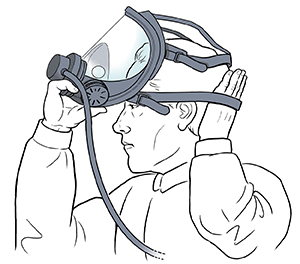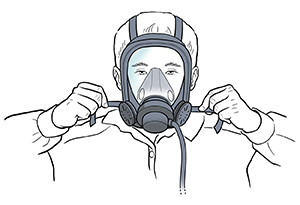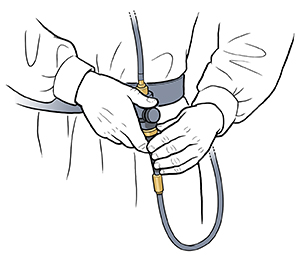Atmosphere-Supplying Respirators
Atmosphere-supplying respirators provide the greatest respiratory protection. They let you breathe air from an outside source, such as an air tank or a compressor. They are used where oxygen levels may dip below 19.5% or where certain gases and vapors are highly concentrated.
Common types
There are three types of atmosphere-supplying respirators:
-
Air-supplied respirators. This type provides air through a hose attached to an outside supply. The air may come from a compressor or a tank. Air then flows into the mask as you breathe.
-
Self-contained breathing apparatus (SCBA). An SCBA allows you to move while carrying an air supply (usually on your back) . Air flows from a tank into the mask. The tank must hold enough air to allow at least 30 minutes of use.
-
Combination respirators. This type provides air through a hose from a stationary source, in the same way that an air-supplied respirator does. It also includes a small air supply tank, like the SCBA. This tank can be used if the stationary source fails.
How to put the respirator on
Read the steps below. Atmosphere-supplying respirators have a mask that's worn like a half-mask or full-face respirator. But instead of a filter or cartridge, an air line fits into the mask. Full-face masks may need special attachments to hold eyeglasses. Facial hair, skin problems, certain dental work, and other factors may prevent a good fit.
 |
| Place the mask over your face. Put the lower strap in position first, then the upper strap. |
 |
| Adjust the straps to ensure a secure but comfortable fit. |
 |
| Check that the air-supply hose is secure. Also be sure the regulator is working properly. |
How to care for them
Inspect your respirator each time before you put it on. Look for cracks, dents, torn straps, or broken fittings. Inspect all hoses. Check that the air tank is full or that the compressor is working. Ensure that hazardous gases, vapors, fumes, or other contaminants are kept away from the air supply. Wash the mask in warm water with a mild soap. Or follow instructions from your employer or the manufacturer. Rinse in water. Then dry with a lint-free cloth or let it air-dry. When not in use, place the mask in a bag. Store it in a cool, dry place.
Online Medical Reviewer:
Chris Southard RN
Online Medical Reviewer:
Marianne Fraser MSN RN
Online Medical Reviewer:
Vinita Wadhawan Researcher
Date Last Reviewed:
10/1/2024
© 2000-2025 The StayWell Company, LLC. All rights reserved. This information is not intended as a substitute for professional medical care. Always follow your healthcare professional's instructions.